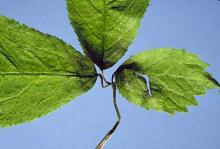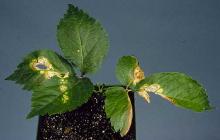By M. Putnam
Cause The fungus Alternaria panax, which is specific to ginseng. The fungus was found in Oregon and Washington for the first time in 2000, although it had been in British Columbia for many years. This disease affects both seedlings and established plants. The fungus will be a problem anywhere temperatures are moderate and relative humidity is at or above 95% in the canopy. The disease is worse in beds that are thickly planted and subject to prolonged moisture retention.
The fungus survives the winter on infected stems or leaves in the ginseng bed. Infection may first appear in the spring on young shoots shortly after they emerge from the soil or mulch. Wind, water splash, tools, or people moving through the beds can disperse the spores from stem or leaf lesions. During damp weather or high humidity, these spores will land on plant surfaces and initiate new infections. Sporulation, dissemination, and infection can occur several times within a single growing season.
Symptoms The fungus causes an elongated brown lesion on the stem, which becomes velvety with spores as the disease progresses. Stems may become girdled by the lesion, which causes the top of the plant to wilt or topple over. Leaves may also become infected. Leaf lesions begin as watersoaked or oily looking spots or, depending on the environmental conditions, yellow spots that later enlarge and dry out in the center. Leaf spots are usually noticed when the centers of the lesions are tan or straw color and are bordered by a thin brown margin, which is surrounded by yellow tissue. Roots are not normally affected.
Cultural control
- Avoid overcrowding and space plants for good air movement within the beds. A good goal is 120 plants/sq yard; for example, use 90 to 100 lb seed/A if germination rate is 70%.
- Increase aeration by planting where neighboring shrubbery or conifer canopies don't obstruct air movement.
- Lift shade cloth on the sides of gardens on cloudy days to promote air movement.
- Avoid using straw mulch; disease may be worse where straw is used. Straw is also attractive to slugs.
- In small gardens it may be possible to hand pick and remove affected stems and foliage.
- Irrigate early in the day so leaves will have a chance to dry before evening.
Chemical control In beds where this disease has been confirmed, applications must begin as soon as plants emerge in the spring. Repeated applications are necessary when environmental conditions are favorable. Tank-mix and/or alternate products from different groups with different modes of action to prevent the buildup of resistant fungi. Limit the use of any one group during crop production.
- Affirm WDG at 6.2 oz/A. Can be used in structures but not open fields. Not for production of edible commodities. Group 19 fungicide. 4-hr reentry.
- Aprovia Top at 13.5 fl oz/A. Do not apply within 15 days of harvest. Group 3 + 7 fungicide. 12-hr reentry.
- Bravo Weather Stik at 2 pints/A. Do not apply within 14 days of harvest. Group M5 fungicide. 12-hr reentry.
- Copper-based materials can be used when tank-mixed with iprodione and a spreader-sticker. Thorough coverage is essential. Group M1 fungicides.
- Badge X2 at 1 to 3.5 lb/A. 48-hr reentry. O
- Cueva at 0.5 to 1 gal/100 gal water/A. May be used on day of harvest. 4-hr reentry. O
- Cuprofix Ultra 40 Disperss at 1.75 to 2.5 lb/A. 48-hr reentry.
- Kocide 3000 at 1 to 1.75 lb/A. 48-hr reentry.
- Nordox 75 WG at 2.25 lb/A. 12-hr reentry but functionally 24-hr since it must be tank-mixed with iprodione.
- Nu-Cop 50 DF at 2.1 lb/A. 48-hr reentry.
- Echo 720 at 2 pints/A. Do not apply within 14 days of harvest. Group M5 fungicide. 12-hr reentry.
- Elatus at 7.3 oz/A. Do not use within 15 days of harvest. Group 7 + 11 fungicide. 12-hr reentry.
- Iprodione-based products. Do not apply within 36 days of harvest. Group 2 fungicides. 24-hr reentry.
- Iprodione 4L AG at 1 to 2 pint/A.
- Meteor at 1 to 2 pint/A.
- Rovral 4 Flowable at 1.5 to 2 pint/A in at least 10 gal/A water.
- Luna Sensation at 7.6 fl oz/A. Do not use within 7 day of harvest. Group 7 + 11 fungicide. 12-hr reentry.
- Luna Tranquility at 16 to 27 fl oz/A. Do not use within 30 days of harvest. Group 7 + 9 fungicide. 12-hr reentry.
- Mancozeb (such as Dithane, Manzate Pro-Stick, or Penncozeb) at 1.8 or 2 lb/A depending on specific product. Do not apply within 30 days of harvest. Group M3 fungicides. 24-hr reentry.
- Merivon at 4 to 5.5 fl oz/A. Do not use with EC or oil-based products. Do not use within 7 days of harvest. Group 7 + 11 fungicide. 12-hr reentry.
- Miravis Prime at 6.8 fl oz/A. May be applied day of harvest. Group 7 + 12 fungicide. 12-hr reentry.
- Neem oil extracts (such as Green Light Neem Concentrate for home use) are registered, but efficacy is unknown. Do not use with or close to sulfur applications. H O
- Omega 500 F at 1 to 1.5 pints/A. Do not use within 30 days of harvest. Group 29 fungicide. 12-hr reentry.
- Ph-D WDG at 6.2 oz/A. Can be used day of harvest. Group 19 fungicide. 4-hr reentry.
- Quadris Flowable at 6 to 15.5 fl oz/A at 7- to 14-day intervals. May be applied day of harvest. Group 11 fungicide. 4-hr reentry.
- Quadris Top at 10 to 14 fl oz/A. May be applied on the day of harvest. Group 3 + 11 fungicide. 12-hr reentry.
- Regev at 4 to 8.5 fl oz/A. Do not apply within 2 days of harvest. Group 3 + BM01 fungicides. 12-hr reentry.
- Scala SC at 18 fl oz/A. Do not apply within 30 days of harvest. Group 9 fungicide. 12-hr reentry.
Note Aliette is best used only when Phytophthora root rot or foliar blight is also in the garden. Do not tank-mix with copper-based products. Do not spray on foliage with copper residue unless pH has been adjusted to 6 or greater using a buffer.
References Ginseng Production Guide. 1998. Province of British Columbia Ministry and Association of Ginseng Growers of British Columbia, British Columbia Ministry of Agriculture, Fisheries and Food, 808 Douglas St., Victoria, BC V1T 6M2.
Putnam, M. 1989. Pathogens. In: Ginseng: A Concise Handbook. Algonac, MI: James A. Duke Reference Publications, Inc.



